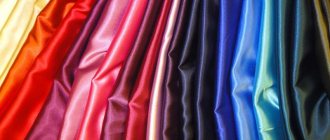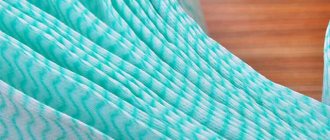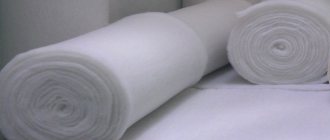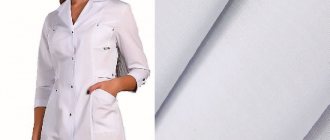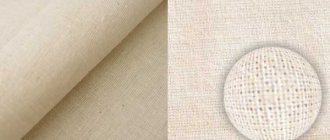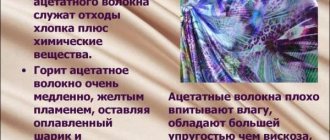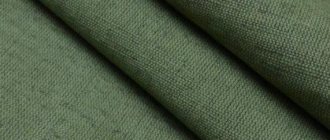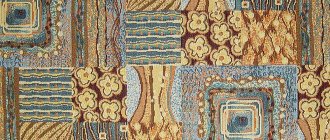Description and composition
What is felt? From the Turkic language the name is translated as “blanket”. This is a dense non-woven material made from felted sheep wool. The best felt is made from the fine down of goats or rabbits. They are thinner and softer.
Appearance of felt
The material has a unique low thermal conductivity, but at the same time allows air to pass through well. Thanks to these features, felt makes excellent hats and warm shoes, and coverings for yurts are also made from it.
Made from animal wool, sheep is usually used. Thanks to the top scaly layer (cuticle), wool fibers can adhere to each other under the influence of steam and hot water. Felting is done according to this principle, resulting in separate felted pieces of material.
Important! In machine production, felt is produced in sheet rolls of the required thickness.
Yurt
What kind of fabric
Felt is a natural non-woven material characterized by its unique ability to accumulate heat. It is not for nothing that felt boots have always been considered the warmest footwear, in which the feet do not freeze even in severe frosts. Felt can be different: coarse and light felt, plain or decorated with printed pictures, thick and thin, almost like paper. But one thing is always the same: the fabric is made only from natural wool.
Answering the question, what is felt, let us turn to the history of the appearance and characteristics of the material.
Historical reference
For the first time, the material, which later received the name felt fabric, appeared around the 5th-6th centuries BC. Then people domesticated goats and learned to use their thin, soft wool in a similar way. There is a legend that back in Noah's Ark, in forced cramped conditions, animals rubbed against each other, and their fluff fell off naturally.
The word “ojlyk” is of Turkic origin, translated as “blanket”. Indeed, fine wool felt provides excellent warmth, which is why it has long been used by nomadic peoples as warm blankets. Made from natural wool, it did not interfere with proper air circulation, so the body did not sweat, but did not feel cold either. Now felt blankets are not so common, they have been replaced by products from other materials, but woolen fabrics are still actively used in modern industry.
Description
It would not be clear what this material is without a more detailed description. Dense, woolen, warm, rough to the touch, with characteristic protruding fibers. Easy to cut, does not crumble, comes in different thicknesses.
There is nothing synthetic about traditional, real felt, just goat or sheep wool. But now manufacturers offer an artificial one, which we will also tell you about.
History of origin
For many of the nomadic tribes of Central Asia, this was the first material that they could obtain and use. It is believed that felt appeared in the 5th-6th millennium BC. BC, when domesticated dogs and horses helped increase sheep herds.
Important! Since wild sheep do not have a cuticle, felt could only be obtained from domesticated animals.
At first, the felt had the natural color of sheep skin; after some time, the material began to be colored using natural dyes:
- The green color was extracted from a mixture of walnut, nettle and mulberry leaves;
- Yellow - from onion peel;
- Gray - from bean broth;
- Brown - from a decoction of nut shells;
- Pink - from blue plum flowers and wild poppy flowers.
A flock of sheep
Later, by mixing dyes, other colors were obtained.
You might be interested in what crepe is: characteristics and composition of suit fabric
At the same time, much attention was paid not only to the beauty and brightness of the shades, but also to their resistance to washing, precipitation and fading during use. Oak ash, copper sulfate, sauerkraut juice, and rusty nails were used to secure the flowers.
Making felt carpet
Ancient tribes used the material quite widely: they made headdresses from thin felt, and from thick felt they made armor, shoes, coverings for yurts and horses. The products were decorated with applique fabric, felt and leather, embroidery, and decorative stitches. It is noteworthy that small things were usually done by women, large ones by men.
There was no felt in Russia. The Slavs made semi-felt, a classic example of such fabric is cloth. However, felted headdresses were known to the peoples of the Volga and Urals regions; they were also produced by handicraft in Novgorod in the 14th century. Footwear (felt boots) appeared only in the middle of the 19th century, but peasants quickly appreciated its advantages.
Gray cloth
Felt: description, important characteristics and composition
Felt is a raw material that is obtained by compacting and pressing wool fibers. For its production, both natural wool, mainly sheep, and synthetic materials from petroleum products and cellulose are used.
There are several types of felting:
- Dry or needle felting.
In this method, dry wool is repeatedly pierced with special serrated needles until it becomes felted. Through the process of repeated piercing, the fibers form a homogeneous material. The needles used in the process are extremely fine.
Properties and performance characteristics
Felt has certain characteristics and properties that are especially important for builders:
- Felt can be set on fire, but it does not burn, but smolders, since there is not enough oxygen for the wool to burn;
- It can absorb formaldehyde and absorb harmful substances that "stick" to sheep's wool;
- It can break down and absorb odors and toxins;
- Felt is the best natural heat insulator. Sheep wool has low thermal conductivity and does not protect against frost; the temperature is maintained by small air cavities, which are created by the wool fibers.
Important! Even if the felt absorbs moisture, it will retain all its properties and remain dry to the touch.
Felt insulation for construction
Types and their differences
There are several types of felt. They differ in some characteristics and areas of application.
Felt is mainly divided into:
- Technical pure wool: in its production, pure raw materials are used, which are processed by “wet felting”. The density of such material is 0.15-0.39 grams per square meter. cm, thickness - 0.2-3 cm;
- Needle-punched or textile: based on composition, it is divided into wool, pure wool, wool blend and synthetic options. Density is 200-1600 grams per square meter. cm, thickness - 0.1-1 cm. Needle-punched felt can have up to 20 shades.
Color options
Composition and types
The history of felt began after people managed to tame wild sheep. True, initially their wool was not suitable for making the material: the structure of the hairs was distinguished by the absence of scales, thanks to which the hairs would be bonded to each other under the influence of high temperatures and moisture. But the fur of domestic sheep has just such a feature. So, as a result of the felting procedure, a dense material is obtained.
Nowadays, the raw material for felt is also mainly sheep's wool. But there are also exceptions. If you use the wool of rabbits and goats, which is much thinner, then you get a type of felt - felt. Hats, bags, and outerwear items are usually made from it.
There are also other types of felt. Most of them are only suitable for creating certain things.
- Technical. This felt is the thickest - up to twelve millimeters. It is used for sound insulation, as a substrate for linoleum, and filters are made from it.
- Furniture. A softer variety.
- Shoe. It is used both for the manufacture of shoes themselves and for insoles.
- Yurt - used by nomadic peoples to build yurts.
Application area
Depending on the type of material, it is used in the manufacture of:
- Clothes: coats, bags, hats;
- Shoes: felt boots and slippers, insoles;
- Toys and decorative items;
- Construction materials and furniture: filters, gaskets and substrates, soundproofing and roofing materials;
- Furniture, mattresses and cars;
- Polishing, wiping and processing materials, such as split wood;
- Saddlery products;
- Yurt.
You might be interested in Description of the veil, features of the fabric and use of the material for sewing curtains
Felt and felt in the modern world
Felt and felt, as a type of felt, are extremely flexible and versatile materials. Despite their ancient history, they are attracting more and more fans, because felt and felt are environmentally friendly, and modern society prefers natural objects and fabrics. Felt products can look quite appropriate in the image of a modern girl and even add some zest. Felt products are often chosen by people who prefer folk or eco-style in the interior.
And it is simply impossible to describe the entire list of manufactured products. These include shawls, scarves, tops, and jackets. Felt slippers are very popular. These materials are often used as decoration for women's accessories - hairpins, brooches. The popularity of felt is just being revived, and this “handmade” material has a great future.
Finally, a selection of photographs of celebrities in felt hats.
And in this online store of our partners you can buy very high-quality felt at low prices
Felt products
Already the first nomadic tribes used felt in a variety of areas. What is felt made of today? Its uses are also varied: clothing, furniture, jewelry, home textiles. Many people use the material as a hobby: sewing clothes or felting the fabric itself.
Felt for felt boots and house slippers
They are easy to sew yourself at home. It is necessary to choose fabric depending on the specific type of footwear: felt for felt boots should be thicker, for slippers - thinner. Products can be decorated with embroidery and appliqués.
Felt shoes
Application for tailoring
You can make various clothes from felt fabric: coats, vests, skirts, dresses, jackets. The material is especially popular for outerwear: coats, mittens, muffs. Felt clothing can be worn even in summer; winter versions are usually sewn with warm linings.
Felt outerwear
Decoration of felt products
To decorate felt products, you can use appliqués made of the same fabric or leather, embroidery, and decorative stitches. You can also use felt of different colors.
Decor example
Advantages
The hairs of sheep or goat wool adhere very tightly to each other, creating a unique fabric. Its main advantage is thermal conductivity, which has long allowed it to be used in felt blankets, shoes, outerwear, to build yurts or to insulate houses. But there are a number of other undeniable advantages:
- environmental friendliness, hygiene;
- high breathability;
- lightness, despite the density of matter;
- the material itself is very soft;
- antibacterial, harmful microorganisms do not live in it;
- durability, even thin felt lasts for years;
- affordable price.
How to make fabric at home?
Felt fabric is easy to make at home. For this you need the wool of a domestic animal: sheep, ram, rabbit, goat. It is best to use ready-made wool: it will be cleared of debris, combed, processed and dyed in the desired color. Otherwise, you will need to prepare it yourself.
You will also need:
- Bubble film;
- Roller or rolling pin;
- Warm soap solution;
- Napkins.
The manufacturing process at home
The felting process itself takes place in several steps:
- Cover your work area with film and make a concentrated soap solution from laundry soap;
- Place a layer of wool felt on the table, moisten it with water (it is better to use a spray bottle) and cover with bubble wrap;
- Press firmly on the film so that the water is distributed evenly, then roll over it;
- Remove the film, put on the second layer and wet it;
- Repeat until desired thickness is obtained;
- Remove excess water with napkins, trim uneven edges and dry the fabric.
Important! To avoid mistakes and understand the intricacies of the process, you should watch the training video in advance.
You might be interested in What is wool: a description of the properties of all varieties
Nuances of product care
Although seemingly rough in appearance, felt is a delicate fabric that requires special care .
- Things are washed only in cold water.
- Products cannot be machine washed.
- Do not bend or compress the product while washing. Washing movements should be as light and gentle as possible. Upon completion of washing, lightly twist the product and allow the water to drain. Then dry with a towel.
- Do not use bleaches or stain removers.
- After washing, shoes are dried on shoe trees. After washing, bags are stuffed with cellophane to maintain their shape.
- Dry products away from heating appliances and gas burners.
- Direct exposure to sunlight during drying deteriorates the structure of the fabric.
Important. Felt made from artificial fibers is less whimsical. Can be gently washed in a washing machine and ironed on the wool setting.
Fabric care
In order for felt products to last longer, it is necessary to properly care for them. The basic principles are as follows:
- It is best to use dry cleaning, vacuuming;
- It is best to wash by hand, after brushing with a dry brush or soaking in cold water;
- You need to squeeze it carefully, squeeze it out lightly (you can blot it with a towel), without twisting or stretching;
- You need to dry your shoes or hats on a special dryer, and dry your bags and backpacks by stuffing them with newspapers or bags. This is necessary to maintain the shape of the product;
- It is better to store things in cotton bags or paper bags, treated with moth repellent. Bulk items can be stuffed with something to maintain their shape.
Washing felt products: shoes, bags, toys, etc.
Washing is acceptable in almost any case, but it must be done by hand using cold or lukewarm water and special preparations for wool containing lanolin.
Shoes (felt boots, slippers, insoles) are soaked in cold water, then washed without twisting or bending, you can use a brush. Then the product is lightly squeezed, lightly wrung out in a towel and dried on a block.
You can wash the bag in the same way, after which it is stuffed with newspapers and dried with an iron (Wool mode). Felt toys and rugs are the easiest to wash, but they should not be dried near heat sources.


